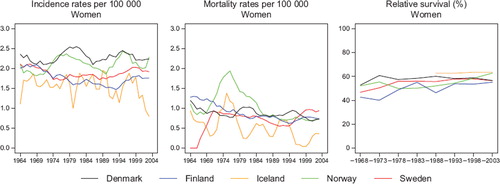Abstract
Cancers of the female genital organs constitute more than 12% of all female cancers in the Nordic countries. The group includes cervix uteri, corpus uteri, ovary and other female genital organs including vulva and vagina, and in this study we compare the development in the Nordic countries regarding incidence, mortality and relative survival. Material and methods. Data were retrieved from the NORDCAN database for the period 1964 to 2003, grouped into eight 5-year periods. The patients were followed up until the end of 2006. Analyses comprised trends in 5-year relative survival, excess mortality and age-specific relative survival. Results. A substantial reduction of cervical cancer incidence followed the introduction of population-based screening in the 1970s and was also accompanied by a modest improvement in survival. Incidence trends in cancer of corpus uteri varied between the countries but the survival increased by around 20 percentage points during the study period in all countries. Ovarian cancer patients have the lowest survival among female genital cancers, but survival increased 10–15 percentage points over the 40 years of observation, while the incidence and mortality were rather stable throughout the observed period. Cancers of the other female genital organs, including vulva and vagina, are rare diagnoses and only small changes in incidence, mortality and survival have been observed over time. Conclusion. The declining trends in cervical cancer incidence and mortality, and improving survival of corpus uteri cancer patients, are in contrast with the rather poor prognosis associated with an ovarian cancer diagnosis. Cancer-specific differences between countries in the survival of female patients diagnosed with cancers of the cervix uteri, corpus uteri and other female genital organs are small.
Cancers of the female genital organs (cervix uteri, corpus uteri, ovary, and other female genital organs including vulva and vagina) constitute more than 12% of all female cancers in the Nordic countries. Cancer of corpus uteri is the most common in this group and the fourth most common among women with approximately 3 200 incident cases and 560 deaths per year during 1999–2003 in the Nordic countries [Citation1]. The second most frequent, ovarian cancer, comprises almost 2 500 diagnoses and 1 700 deaths annually [Citation1]. Since the mid-1960s, all Nordic countries have had organised screening programmes (Norway started approximately 10 years later) to identify precancerous lesions of the cervix uteri for women around the age-span 20–60. This has reduced cervical cancer incidence by more than 50% since the early 1960s and approximately 1 300 cases were diagnosed every year in the period 1999–2003 [Citation1,Citation2].
The aetiology of the diseases differs, but they share certain risk factors. Obesity, reproductive factors including nulliparity or late childbirth, and unopposed oestrogen HRT are risk factors for cancer of the ovaries and corpus uteri, while the use of combined oral contraceptives is likely protective [Citation3–6]. Human Papilloma Virus (HPV) infection is a necessary but not sufficient cause of cervical cancer [Citation7]. Smoking may modulate the risk of cervical cancer among HPV-positive women, but appears to reduce the risk of cancers of the corpus uteri. HPV and smoking are also associated with cancer of other female genital organs such as vulva and vagina [Citation8].
In the EUROCARE-4 study [Citation9], the European age-standardised 5-year relative survival was 63% for cervical cancer, 76% for corpus uteri, 37% for ovaries, and 59% for vagina and vulva. A Nordic report from 1995 pointed out the importance of age at diagnosis on 5-year survival following cervical cancer. Patients below age 45 in the period 1983–1987 had a relative survival of 82% while the corresponding figure was 34% among women older than 75 years. The same study, based on patients diagnosed in 1958–1987, showed that 5-year relative survival after cancers of the corpus uteri increased steadily during that period in all Nordic countries except Iceland, where no increase was seen for patients diagnosed after 1978 [Citation10]. Relative to the European average, the female genital cancer survival among Nordic patients was similar or higher than the European average with few exceptions [Citation9].
The purpose of this study is to compare the trends in survival following diagnoses of cancer of the female genital organs, in relation to the corresponding incidence and mortality trends in each of the five Nordic countries, Denmark, Finland, Iceland, Norway, and Sweden over the period 1964–2003.
Material and methods
The data sources and methods are described in detail elsewhere [Citation11]. In brief, the study is based on the core dataset in NORDCAN, a database with comparable data on cancer incidence and mortality in the Nordic countries delivered from the national cancer registries, with follow-up for death or emigration for each cancer patient through 2006. The study covers cancer of cervix uteri (ICD-10 C53), corpus uteri (ICD-10 C54), ovaries (ICD-10 C56, C57.0-C57.4) and other female genital organs including vulva and vagina (ICD-10 C51-C52, C57.7-C57.9). We calculated 5-year relative survival for each of the diagnostic groups in NORDCAN for eight 5-year periods from 1964–1968 to 1999–2003. For the last five-year period, hybrid analysis methods were used. Country specific population mortality rates were used for calculating the expected survival. Age-standardisation of relative survival used the ICSS-standard cancer patient populations [Citation12]. We show age-standardised incidence and mortality (World standard), 5-year relative survival, and excess mortality rates for the follow-up periods: the first month, one to three months and two to five years following diagnosis, as well as age-specific 5-year relative survival by country and 5-year period.
Results
Cancer of cervix uteri
Incidence and mortality. The main observation with respect to the age-standardised incidence and mortality trends in cervical cancer was a continuous decline in each of the Nordic countries up to 2003 (). Some deceleration in the rate of decrease in incidence was seen in recent decades, particularly in Finland and Sweden (). In Finland, a transitory increase in cervical cancer incidence was observed beginning in the early 1990s, followed by a period of relative stability; this feature was less evident in the mortality trends, with continual declines in the latest years. Similarly, a short-lived increase in rates in the late-1980s was observed in Norway, and more notably in Iceland slightly earlier, followed by a subsequent period of uniform decline. The incidence and mortality rate in Denmark was twofold that in Finland, Norway, and Sweden in the early 1960s and although rates still varied threefold across the Nordic populations circa 2003 the relative ranking has changed little since the 1970s. Age-standardised incidence rates in 2003 were in the range four to 10 per 100 000 and mortality rates in the range one to three per 100 000, with rates highest in Denmark and lowest in Finland.
Survival
Cervical cancer survival ratios and trends were rather similar in the Nordic countries throughout the study period, including the latest diagnostic period 1999–2003. After a period where trends were quite stable or even decreasing (up to around 1985), small increments in survival of two to three percentage points were observed from the late-1980s to the present, although the absolute increases were somewhat greater in Finland ( and ). The 5-year relative survival estimates remained quite comparable across populations for Nordic patients diagnosed 1999–2003 with ratios only varying between 64% and 68% (). Age at diagnosis was evidently a major determinant of cancer survival, with 5-year relative survival among patients below age 50 years estimated at around 85–90% in the latest period, with survival steadily decreasing as age increased (). The recent and minor increase in overall survival did not appear related to age, although slight but continuous survival increases in patients aged under 50 were observed in the long-term trends.
Table I. Trends in survival for cancer of cervix uteri by country. Number of tumours (N) included and the 5-year age-standardised (ICSS) relative survival in percent with 95% confidence intervals (RS (CI)). Nordic cancer survival study 1964–2003.
Table II. Trends in 5-year age-specific relative survival in percent after cancer of cervix uteri by country. Nordic cancer survival study 1964–2003.
The variability in excess death rates between countries appeared restricted to the first three months after diagnosis, within the first three months, with a slightly higher excess death rate in Denmark (). A decrease in the excess mortality was found for follow-up in the first month in consecutive calendar periods 1964–2003, from about 40 to 20–25 deaths per 100 person years. At two to five years of follow-up after diagnosis the mortality rates were fairly constant at around six per 100 person years, with hardly any variation between countries.
Cancer of corpus uteri
Incidence and mortality. In Norway and Finland, incidence increased steadily during the study period () while a lesser increase was seen in Sweden. No overall changes were seen in Iceland, and in Denmark a decrease was observed since the 1980s, following a rather sharp increase in the preceding decade. In 2003, Denmark and Iceland had the lowest age-standardised incidence of cancer of the corpus uteri at about 13 cases per 100 000 women and Norway the highest (16 per 100 000). Mortality rates were rather stable, although some declines were apparent in Sweden and Iceland since the 1960s. Mortality rates were at a much lower level than incidence (range one to two per 100 000 in 2003), with Sweden having the lowest rate throughout the period.
Survival
In each Nordic country except for Iceland, the 5-year relative survival increased markedly during the period, the increase amounting to 20 percentage points (, ). In Iceland, no increase was apparent between 1978 and 1993, but thereafter an upward trend was seen, although survival remained considerably lower than in the other four countries after 1978. Among Nordic patients diagnosed in 1999–2003 the 5-year relative survival was in the range 75 to 83%, Sweden had the highest survival throughout the period.
Sweden also had the lowest excess death rates during the first year after diagnosis (not shown for months three to 12), but there was no difference in excess mortality between the countries two to five years after diagnosis (). Iceland appeared to have the highest excess death rates one to three months after diagnosis, since 1978.
Table III. Trends in survival for cancer of corpus uteri by country. Number of tumours (N) included and the 5-year age-standardised (ICSS) relative survival in percent with 95% confidence intervals (RS (CI)). Nordic cancer survival study 1964–2003.
Figure 4. Trends in age-standardised (ICSS) excess death rates per 100 person years for cancer of corpus uteri by country and time since diagnosis. Nordic cancer survival study 1964–2003.

The general pattern in the age-specific relative survival was a decline with advancing age from the age group 50–59 in all countries. The youngest patients, aged below 50 years, had worse or similar survival to those aged 50–59 in all countries after 1989, with the exception of Norway ().
Table IV. Trends in 5-year age-specific relative survival in percent after cancer of corpus uteri by country. Nordic cancer survival study 1964–2003.
Ovarian cancer
Incidence and mortality. Ovarian cancer incidence and mortality rates slightly declined in the Nordic countries from the mid-1980s, although in Finland slightly later from the mid-1990s (). The age-standardised incidence rate was around 12–14 cases per 100 000, although there was some variation between the countries. Finland has had lower rates than the other countries in terms of both incidence and mortality but these were fairly constant over the study period. In Denmark and Sweden, on the other hand, the incidence has been historically higher, at approximately 15–16 per 100 000 around 1970, but has constantly decreased subsequently, most notably in Sweden. Mortality followed incidence closely in the Nordic countries, although at a lower level, at approximately seven per 100 000 circa 2003. Mortality was higher in Denmark than in the other countries throughout the period.
Survival
Increasing trends in 5-year survival following ovarian cancer diagnoses were observed in all Nordic countries (), with Denmark and Sweden having the lowest and highest ratios, respectively. Finland and Norway caught up with the Swedish survival in the most recent period while Danish patients still experienced a lower survival than patients in Finland, Norway and Sweden estimated at 33% compared to 41–44% in the other countries (). The survival in Iceland was at about the same level as in Norway and Finland until the mid-1990s whereafter it dropped somewhat.
Table V. Trends in survival for ovarian cancer by country. Number of tumours (N) included and the 5-year age-standardised (ICSS) relative survival in percent with 95% confidence intervals (RS (CI)). Nordic cancer survival study 1964–2003.
Large differences in the absolute level and a decrease over time were observed in the number of excess deaths by time since diagnosis (). The excess mortality rates during the first month after diagnosis were high, starting in the 1960s at around 200 per 100 person years, except in Finland and Iceland where the rate was below 150, and decreased to 80 in the last period 1999–2003. In the follow-up interval of one to three months, excess rates started around 100 and fell to around 70. Denmark had the highest level of excess mortality in the first year following diagnosis, but differences decreased over calendar time, with rates in Sweden considerably lower. In the last follow-up interval, two to five years after diagnosis, the rates were relatively uniform at 10 to 14 per 100 person years, with few differences between countries.
Figure 6. Trends in age-standardised (ICSS) excess death rates per 100 person years for ovarian cancer by country and time since diagnosis. Nordic cancer survival study 1964–2003.

Younger age was associated with higher survival in each of the Nordic countries, and the main increases over time were seen in women below the age of 70 years at diagnosis. Five-year survival in the age group 0–49 in the period 1999–2003 ranged from 63 (Denmark) to 71% (Finland) ().
Table VI. Trends in 5-year age-specific relative survival in percent after ovarian cancer by country. Nordic cancer survival study 1964–2003.
Cancer of other female genital organs (vulva, vagina and other unspecified organs)
Incidence and mortality. The incidence rates of cancer in other female genital organs were at a fairly constant level over time, although with some random variation, at around two per 100 000, with a slightly decreasing trend observed in Finland. The vast majority of cases were vulva cancer constituting 71% of the cases in 1999–2003, while cancer of the vagina and other unspecified organs constituted 18% and 11%, respectively. Mortality rates were somewhat lower with trends declining throughout the observed period to less than one per 100 000 circa 2003 ().
Survival
Some increases in survival were observed with 5-year other female genital survival increasing from around 50 to nearly 60% from 1964 to 2003 ( and ). The survival was slightly lower in Finland in the whole period, with Norway and Iceland exhibiting the highest survival in the last period at above 60% (although with wide confidence intervals), with the other countries close behind with survival at around 55–57% (). The excess death rates were around 40 in the first month of follow-up, 30 one to three months after diagnosis about six deaths per 100 person years at two to five years follow-up, with a slight decline with time and little variation between countries (). Survival decreased with age at diagnosis and increased with time ().
Table VII. Trends in survival for cancer in other female genital organs by country. Number of tumours (N) included and the 5-year age-standardised (ICSS) relative survival in percent with 95% confidence intervals (RS (CI)). Nordic cancer survival study 1964–2003.
Table VIII. Trends in 5-year age-specific relative survival in percent after cancer in other female genital organs by country. Nordic cancer survival study 1964–2003.
Discussion
To summarise the main incidence trends established in this paper, there were large declines in cervical cancer in the Nordic countries, slight increases in cancer of corpus uteri, small decreases in ovarian cancer and little change in cancer of the other female genital organs. For all female genital cancers, mortality has been slightly decreasing while survival has tended to increase slightly. The Icelandic figures should be interpreted cautiously given large random variation due to small numbers.
The decline in cervical cancer incidence started in the mid-1960s in each of the Nordic countries with the exception of Norway, where the decrease started 10 years later. This is an observation attributed to differences in organised screening programmes for early detection of precancerous lesions [Citation13]. The variations in rates and the relative extent of declines were shown to match the extent and intensity of population-based screening in the respective countries [Citation2], providing substantial support for the effectiveness of early detection by organised programmes [Citation14]. The temporary rise in incidence occurring in Iceland during the 1980s was due to an increase in the proportion of women ever attending the nationwide screening program through implementation of a new electronic invitation system. This focused first on women who had not attended the program within the past five years and resulted in rapidly rising three year attendance rates followed by the peak in incidence as a consequence [Citation15]. Cytological screening for precancerous lesions and following treatment have been the major factor in the reduction of cervical cancer incidence and mortality in the Nordic countries, while in contrast, 5-year relative survival has remained largely stable at around 60% in each of the Nordic populations from the 1960s through to the 1980s [Citation10]. Thereafter, a slight increase in survival has been observed.
A EUROCARE study published in 2007 indicated that the cervical cancer survival five years after diagnosis in the Nordic countries was among the highest in Europe [Citation16]. Geographical and temporal variations in cervical cancer incidence and mortality in these populations however are mainly the product of two major and competing factors. One relates to the timing and extent of implementation of organised screening programs [Citation2,Citation14]. The second results from the changing pattern of sexual behaviour, with increasing transmission of oncogenic types of HPV and a higher prevalence of persistent infection increasing the risk of cancer of cervix uteri. The latter phenomenon is evident in successive birth cohorts in a number of European populations born 1930–1950 [Citation17]. The historical declines in survival observed in certain populations may result from a selective prevention of slower-growing tumours via screening [Citation18].
Clinical stage and age at diagnosis are clear prognostic factors for cervical cancer, but the relative survival increases in the Nordic patients among those diagnosed at early age are not particularly substantial relative to other age groups. Older women might have been diagnosed at a later stage since they never have been offered screening, and may have had co-morbidities leading to a choice of more conservative treatment options, while younger women, often diagnosed at earlier clinical stages, are more likely to receive and accept more aggressive treatments with a curative intent. It is still unclear as to the role of histological subtype in subsequent survival differences, despite much research activity [Citation16,Citation19–22]; some have reported a higher survival for squamous cell carcinoma, while others have reported no difference in prognosis. In a Finnish study it was shown that the incidence of squamous cell carcinoma of cervix uteri declined following the introduction of the screening programme while the incidence of adenocarcinoma was rather stable over time [Citation23]. A possible interaction with age at diagnosis, with higher survival for both cervical adenocarcinoma in younger women, and cervical squamous cell carcinoma diagnosis among older women has also been noted [Citation16].
The main symptom of cancer of the corpus uteri is bleeding and the disease is usually diagnosed at an early stage leading to a rather good prognosis. Icelandic patient survival has previously been reported to deviate from the other Nordic countries since around 1978 [Citation10], and this result was confirmed and updated in this study. Swedish patients have a survival a few percentage points higher than patients in the other Nordic countries over the study period, although this was confined to the first three months after diagnosis, most notably during the first month.
Varying coding practices in the Nordic countries may also contribute to the country-specific differences in survival estimates from cancer of the corpus uteri; the category for “uterus other” (ICD-10 C55 & C58), associated with poorer survival, was seldom used in Iceland and has been used variably in the other countries, but most frequently in Sweden. On including this unspecified category with cancers of corpus uteri to explore the impact of that more advanced cases incorrectly might have been classified as “uterus other”, the relative survival ratios were lowered by one to four percentage points, most notably in Sweden, thus resulting in no changes in the relative ranking of survival between countries, except in Iceland, where women who still experienced a poorer survival by four to eight percentage points.
The use of HRT increased steadily in Iceland from the late 1970s [Citation24] and a similar trend is likely to have occurred in all the Nordic countries. A Nordic report for the years 1995–2007 showed an increasing use of both unopposed oestrogens and in combination with progesterones between 1995 and 2000, and a decline thereafter in all countries [Citation25]. The use of unopposed oestrogens is associated with a substantially increased risk of the diagnosis of endometrial cancer, without a corresponding increase in mortality [Citation26]. The increasing use of HRTs in the Nordic countries during the last three decades may therefore explain part of the improved survival. Of the five Nordic countries, the lowest use of oestrogens was reported for Denmark [Citation25] so the postulated effect on survival would have been smallest in Denmark.
Since treatment has not changed much during the last 30 years [Citation27], factors behind the steadily increasing survival, besides earlier diagnosis and better peri-operative care, could be the increased oestrogen exposure (HRT) increasing the frequency of corpus uteri cancer diagnoses associated with better prognosis [Citation26].
Ovarian cancer trends are encouraging with overall declines in both incidence and mortality as well as increasing survival. Nevertheless the prognosis is poor with 5-year relative survival around 40%. Due to diffuse early symptoms the majority of patients are diagnosed at an advanced stage, unless incidentally found during diagnostic procedures for other diseases. Tumour stage at diagnosis has been identified as an important prognostic factor [Citation28,Citation29]; in one report, Danish women with a localised ovarian cancer had a significantly reduced relative excess mortality risk compared with those who were diagnosed with tumours with regional or distant metastases [Citation29]. Unfortunately, the currently available screening methods do not have adequate sensitivity or specificity to justify organised programmes, and thus attentiveness among clinicians to women showing (vague) symptoms is important. Diagnosis and treatment of ovarian cancer patients in Denmark is yet to be restricted to specialised centres which in other countries has been shown to improve the results [Citation30], and may be one factor behind the poorer Danish survival. Surgical removal of the ovaries and debulking of peritoneal metastases is the primary treatment, often combined with postoperative chemotherapy. Operating methods have improved with time and combined with more effective combinations of chemotherapy for women with advanced ovarian cancer may have contributed to improving survival [Citation31,Citation32].
There are no major differences between the Nordic countries regarding survival among women with cancer of the vulva, vagina and other unspecified genital organs. Vaginal and vulvar cancers are mainly of squamous cell type and have certain aetiologic features, such as being HPV- and smoke-related, in common with cervical cancer [Citation8]. The development and introduction of HPV vaccine may consequently increase the prospect for prevention of both cervical as well as vaginal and vulvar cancer.
Death certificates have not been used as a source of cancer notification in Sweden and death certificate initiated cases tend to have an inferior survival compared to others which consequently could bias the results. This could partly explain the higher ovarian cancer survival in Sweden relative to elsewhere, especially since the excess mortality in the first three months was considerably lower than in the other countries. Studies of completeness of the Swedish Cancer Registry though, have demonstrated a high completeness for cases of the female genital organs, indicating that non-use of death certificate information has only a minor influence on the survival estimates [Citation33,Citation34].
In conclusion, this study points to encouraging trends for cancer of cervix uteri as the disease is becoming less common, and for corpus uteri where survival continues to improve. Prognosis is still poor for women diagnosed with ovarian cancer however, and there remain relatively large differences between countries. Cancer-specific differences between countries in the survival of female patients diagnosed with cancers of the cervix uteri, corpus uteri and other female genital organs are small relative to many other cancer sites.
Acknowledgements
The Nordic Cancer Union (NCU) has financially supported the development of the NORDCAN database and program, as well as the survival analyses in this project. The authors report no conflict of interest. The authors alone are responsible for the content and writing of the paper.
Declaration of interest: The authors report no conflicts of interest. The authors alone are responsible for the content and writing of the paper.
References
- Engholm G, Ferlay J, Christensen N, Bray F, Klint Å, Olafsdóttir E, . NORDCAN: Cancer incidence, mortality, and prevalence in the Nordic countries. Version 3.3. http://www.ancr.nu. Association of Nordic Cancer Registries, Danish Cancer Society; 2008.
- Laara E, Day NE, Hakama M. Trends in mortality from cervical cancer in the Nordic countries: Association with organised screening programmes. Lancet 1987;1(8544):1247–9.
- Hankinson SE, Danforth KN. Ovarian cancer. Schottenfeld D, Fraumeni JF Jr. Cancer epidemiology and prevention. 3rd Oxford: Oxford University Press; 2006. 1013–26.
- Lacey JVJ, Colditz GA, Schottenfeld D. Exogenous hormones. Schottenfeld D, Fraumeni JF Jr. Cancer epidemiology and prevention. 3rd Oxford: Oxford University Press; 2006. 468–88.
- Cook LS, Weiss NS, Doherty JA, Chen C. Endometrial cancer. Schottenfeld D, Fraumeni JF Jr. Cancer epidemiology and prevention. 3rd Oxford: Oxford University Press; 2006. 1027–43.
- Karim-Kos HE, de Vries E, Soerjomataram I, Lemmens V, Siesling S, Coebergh JW. Recent trends of cancer in Europe: A combined approach of incidence, survival and mortality for 17 cancer sites since the 1990s. Eur J Cancer 2008; 44: 1345–89.
- Schiffman MH, Hildesheim A. Cervical cancer. Schottenfeld D, Fraumeni JF Jr. Cancer epidemiology and prevention. 3rd Oxford: Oxford University Press; 2006. 1044–67.
- Madeleine MM, Daling JR. Cancers of the vulva and vagina. Schottenfeld D, Fraumeni JF Jr. Cancer epidemiology and prevention. 3rd Oxford: Oxford University Press; 2006. 1068–74.
- Sant M, Allemani C, Santaquilani M, Knijn A, Marchesi F, Capocaccia R. EUROCARE-4. Survival of cancer patients diagnosed in 1995–1999. Results and commentary. Eur J Cancer 2009; 45: 931–91.
- Engeland A, Haldorsen T, Tretli S, Hakulinen T, Hörte LG, Luostarinen T, . Prediction of cancer mortality in the Nordic countries up to the years 2000 and 2010, on the basis of relative survival analysis. A collaborative study of the five Nordic Cancer Registries. APMIS Suppl 1995; 49: 1–161.
- Engholm G, Gislum M, Bray F, Hakulinen T. Trends in the survival of patients diagnosed with cancer in the Nordic countries 1964–2003 followed up to the end of 2006. Material and methods. Acta Oncol 2010.
- Corazziari I, Quinn M, Capocaccia R. Standard cancer patient population for age standardising survival ratios. Eur J Cancer 2004; 40: 2307–16.
- Hakama M. Trends in the incidence of cervical cancer in the Nordic countries. Magnus K. Trends in cancer incidence causes and practical implications. Washington D.C.: Hemisphere Publishing Corporation; 1982. 279–92.
- International Agency for Research on Cancer. Cervix cancer screening. Lyon: IARC Press; 2004.
- Sigurdsson K, Sigvaldason H. Effectiveness of cervical cancer screening in Iceland, 1964–2002: A study on trends in incidence and mortality and the effect of risk factors. Acta Obstet Gynecol Scand 2006; 85: 343–9.
- Bielska-Lasota M, Inghelmann R, van de Poll-Franse L, Capocaccia R. Trends in cervical cancer survival in Europe, 1983–1994: A population-based study. Gynecol Oncol 2007; 105: 609–19.
- Bray F, Loos AH, McCarron P, Weiderpass E, Arbyn M, Møller H, . Trends in cervical squamous cell carcinoma incidence in 13 European countries: Changing risk and the effects of screening. Cancer Epidemiol Biomarkers Prev 2005; 14: 677–86.
- Saxen E, Hakama M. Cancer illness in Finland with a note on the effects of age adjustment and early diagnosis. Ann Med Exp Biol Fenn 1964;42(Suppl 2):1–28.
- Eide TJ. Cancer of the uterine cervix in Norway by histologic type, 1970–84. J Natl Cancer Inst 1987; 79: 199–205.
- Bjørge T, Thoresen SO, Skare GB. Incidence, survival and mortality in cervical cancer in Norway, 1956–1990. Eur J Cancer 1993;29A:2291–7.
- Shingleton HM, Bell MC, Fremgen A, Chmiel JS, Russell AH, Jones WB, . Is there really a difference in survival of women with squamous cell carcinoma, adenocarcinoma, and adenosquamous cell carcinoma of the cervix? Cancer 1995;76(10 Suppl):1948–55.
- Bulk S, Visser O, Rozendaal L, Verheijen RH, Meijer CJ. Incidence and survival rate of women with cervical cancer in the Greater Amsterdam area. Br J Cancer 2003; 89: 834–9.
- Pukkala E, Malila N, Hakama M. Socioeconomic differences in incidence of cervical cancer in Finland by cell type. Acta Oncol 2010; 49: 180–4.
- Armannsdóttir B, Tryggvadóttir L, Jónasson JG, Olafsdóttir EJ, Guðmundsson1 JA. [Use of hormone replacement therapy by Icelandic women in the years 1996–2001]. Laeknabladid 2004; 90: 471–7.
- Health Statistics in the Nordic Countries 2006. Vol 82. Copenhagen, Denmark: NOMESCO Nordic Medical Statistical Committee; 2008. (http://nomesco-eng.nom-nos.dk/filer/publikationer/Helse%202006.pdf, Table 3.7.9)
- Nelson HD, Humphrey LL, Nygren P, Teutsch SM, Allan JD. Postmenopausal hormone replacement therapy: Scientific review. JAMA 2002; 288: 872–81.
- Kitchener HC. Survival from endometrial cancer in England and Wales up to 2001. Br J Cancer 2008;99(Suppl 1):S68–9.
- Yang L, Klint A, Lambe M, Bellocco R, Riman T, Bergfeldt K, . Predictors of ovarian cancer survival: A population-based prospective study in Sweden. Int J Cancer 2008; 123: 672–9.
- Hannibal CG, Cortes R, Engholm G, Kjaer SK. Survival of ovarian cancer patients in Denmark: Excess mortality risk analysis of five-year relative survival in the period 1978–2002. Acta Obstet Gynecol Scand 2008;87: 1353–60.
- Ottesen B, Iversen MG, Kehlet H. [Surgical treatment for ovarian cancer in Denmark 2004–2007]. Ugeskr Laeger 2009; 171: 217–20.
- Kitchener HC. Survival from cancer of the ovary in England and Wales up to 2001. Br J Cancer 2008;99(Suppl 1):S73–4.
- Högberg T, Glimelius B, Nygren P; SBU-group. Swedish Council of Technology Assessment in Health Care. A systematic overview of chemotherapy effects in ovarian cancer. Acta Oncol 2001; 40: 340–60.
- Mattsson B, Wallgren A. Completeness of the Swedish Cancer Register. Non-notified cancer cases recorded on death certificates in 1978. Acta Radiol Oncol 1984; 23: 305–13.
- Barlow L, Westergren K, Holmberg L, Talbäck M. The completeness of the Swedish Cancer Register: A sample survey for year 1998. Acta Oncol 2009; 48: 27–33.





